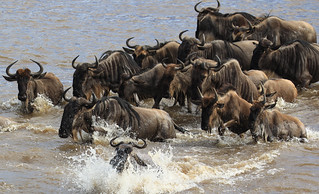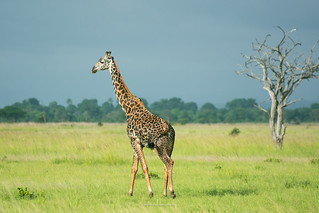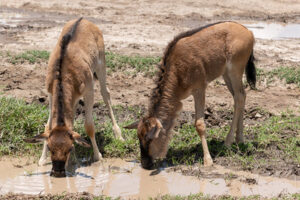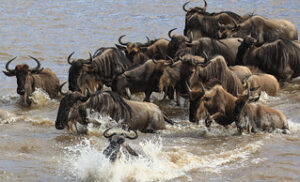The Masai Mara-Serengeti Wildebeest Migration is the mass movement of over 1 Million Wildebeests, together with other animals such as Zebras, antelopes, eland, Impala and Thomson’s gazelles across the Serengeti – Mara ecosystem. The wildebeest migration is an experience that makes Masai Mara unique.
The Masai Mara National Reserve is one of the top visited conservation areas in Africa. The reserve safeguards a diverse ecosystem and some of the unique features include the Oloololo Escarpment, Mara River, Leopard Gorge, wildlife and cultural /Historical sites. The reserve is located in the southwest of Kenya in Narok county. It lies along the Great Rift Valley and the reserve covers an area of 1,510 kilometers squared.
Some of the main activities in Masai Mara include wildlife Viewing through Game drives, Adventure activities which includes Hot air balloon rides and Horse riding, as well as Cultural experiences.
The Great Wildebeest Migration Guide Month by Month
The Wildebeest Migration in Maasai Mara National Reserve is one of the most exciting, moving and thrilling displays of wildlife behavior. A month by month guide or knowing when the annual movement occurs helps visitors to know what to expect considering their travel period.
Besides the wildebeest Migration, visitors need to note that there is an incredible concentration of wildlife throughout the year.
January
During January, the wildebeests start to move from Moru South to Naabi gathering in the southern plains of the Serengeti. The short grasses in the plains are rich and packed with nutrition, ideal for the by-now heavily pregnant wildebeests. During this period, tourists are encouraged to be prepared for some rainfalls at any given period of time.
February
During this month, visitors are in position to see new born calves within the Ndutu conservation area. Over 8,000 wildebeest are born a day In February and very many of the new born babies attract or fall prey to the Cheetahs, Hyenas, lions, Leopards and other animals. The birthing season carries through March.
March
March is a rainy season and it marks the end of the calving season in the wildebeest migration pattern. There’s massive concentration of wildebeest in the Ndutu and Kusini area during the month of March. There’s also predator-prey interactions and exciting wildlife viewing opportunities.
April
During the month of April, the herds team up into large groups and they are joined by Zebras, Topis, Gazelles and many other animals. The Wildebeests start to depart Ndutu conservation area during the first half of April, moving towards Seronero area in search of the fresher grass.
May
The herds start moving from the Southern plains towards seronero area of central Serengeti in search for more nutritious grass and water. The wildebeest continue to move north through the Moru Kopjes towards the Western Corridor.
June
June marks the beginning of the dry season and it is traditionally the Grumeti River crossing period. The wildebeest and Zebras brave the river as the lions, leopards, and hyenas exploit the crossing.
July
July is a peak tourist season because of the Wildebeest movement. It involves Mara River Crossings which gives a thrilling sighting of the wildebeests and other animals like Zebras. Thousands of wildebeests are killed the Lions, Leopards as well as cheetahs and each death mean availability of food for Crocodiles and birds.
August
During the month of August, the survivor wildebeests and other animals continue moving northwards to Kogatende area to cross into Kenya’s Masai Mara National Reserve. Predator prey dynamics continue making it exciting for Wildlife viewing. The animals in the Greater Masai Mara area continue feeding on the lush green grass resources before venturing north towards the private conservancies of Mara North and Olare Orok.
September
In the month of September, the last herds head eastwards through Mara. River crossings continue as well as predator activity. And for anyone visiting around this time will still encounter lots of animals including the big five.
October
During October, the wildebeest migration slows down and the herds begin moving towards western Loliondo and the Lobo area, returning to Tanzania. You will be able to catch the end trail of the herds, as the predators continue to exploit the weakening prey.
November
November features the herds heading to the central Serengeti, in smaller groups and grazing in the lush vegetation and abundant water. This is a quiet and calmer period with fewer tourists but ideal for peaceful wildlife viewing.
December
December comes with short rains and herds head into southern Serengeti where there’s greener and fresh grass covering the plains. This marks the completion of the great Migration Circuit with the survivors back in the southern Serengeti. The circle of the wildebeests begins again as the window for calving sets in.
combined Serengeti-Masai Mara migration safari packages
13 Day best of Tanzania and Kenya safaris

Our combined best of Tanzania & Kenya vacation safari will take to some of the most famous national park in the whole of Africa. It is an all-action small group wildlife safari where you will encounter almost all wildlife that you can meet on African continent. From the big cats the smallest of animal. You will surely have a memorable adventure combined with the visit to the largest lake in Africa in form of Lake Victoria.
| TRIP DETAILS |
| REQUEST INFO |
14 days best of Africa: Tanzania, Rwanda & more

Embark on an extraordinary 14-day journey through the heart of East Africa, where the tapestry of nature unfolds in its most magnificent and untamed form. This meticulously crafted itinerary invites you to traverse three captivating countries – Rwanda, Kenya, and Tanzania – each offering a unique blend of culture, wildlife
| TRIP DETAILS |
| REQUEST INFO |
14 Day Kilimanjaro & northern circuit safari

Embark on a transcendent journey through the heart of Tanzania, where the towering majesty of Mount Kilimanjaro converges with the untamed beauty of the Serengeti. This meticulously crafted 14-day itinerary promises an unforgettable fusion of high-altitude adventure and unparalleled wildlife encounters.
| TRIP DETAILS |
| REQUEST INFO |



